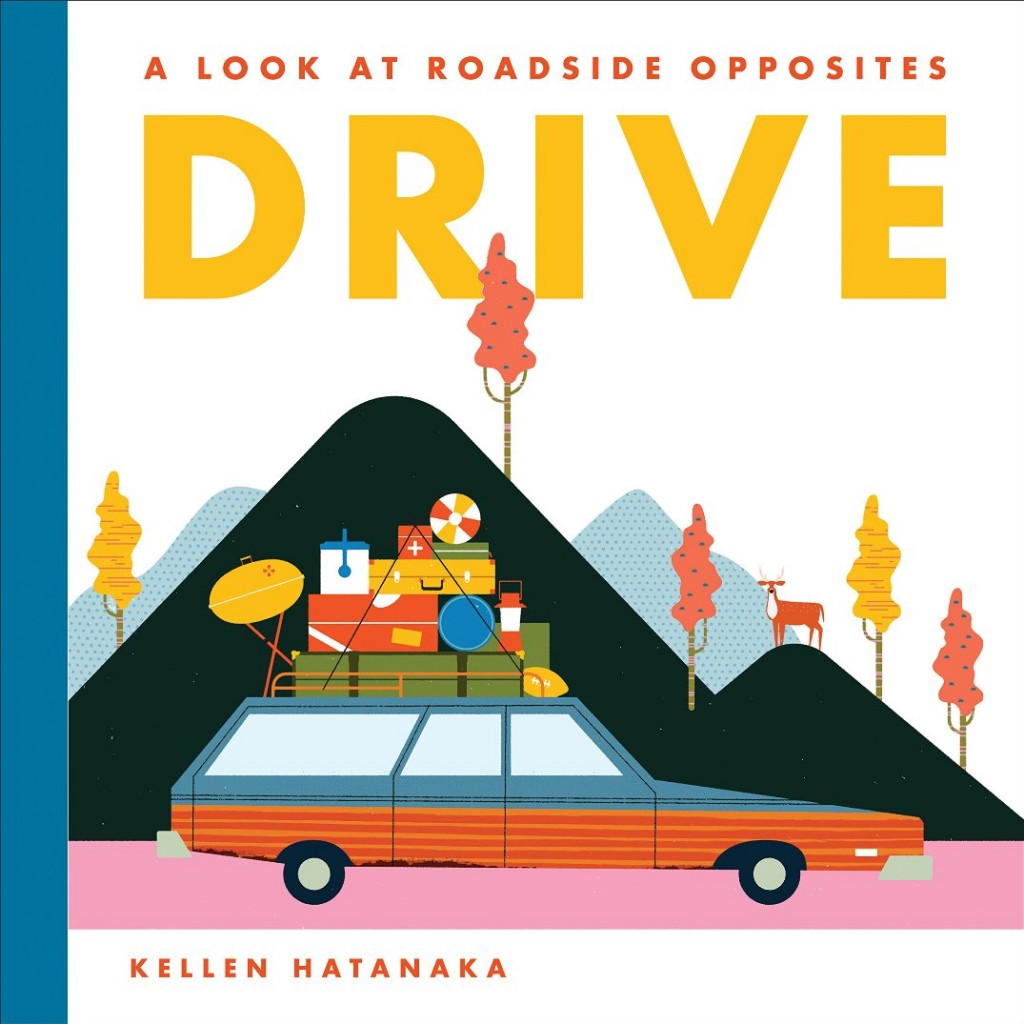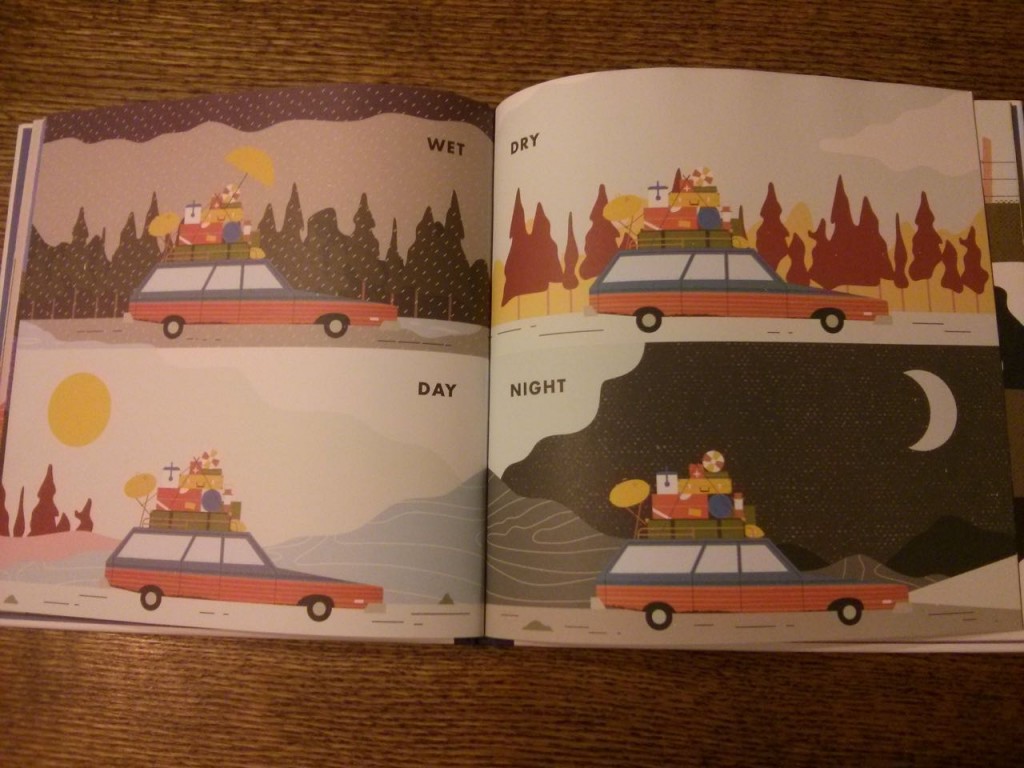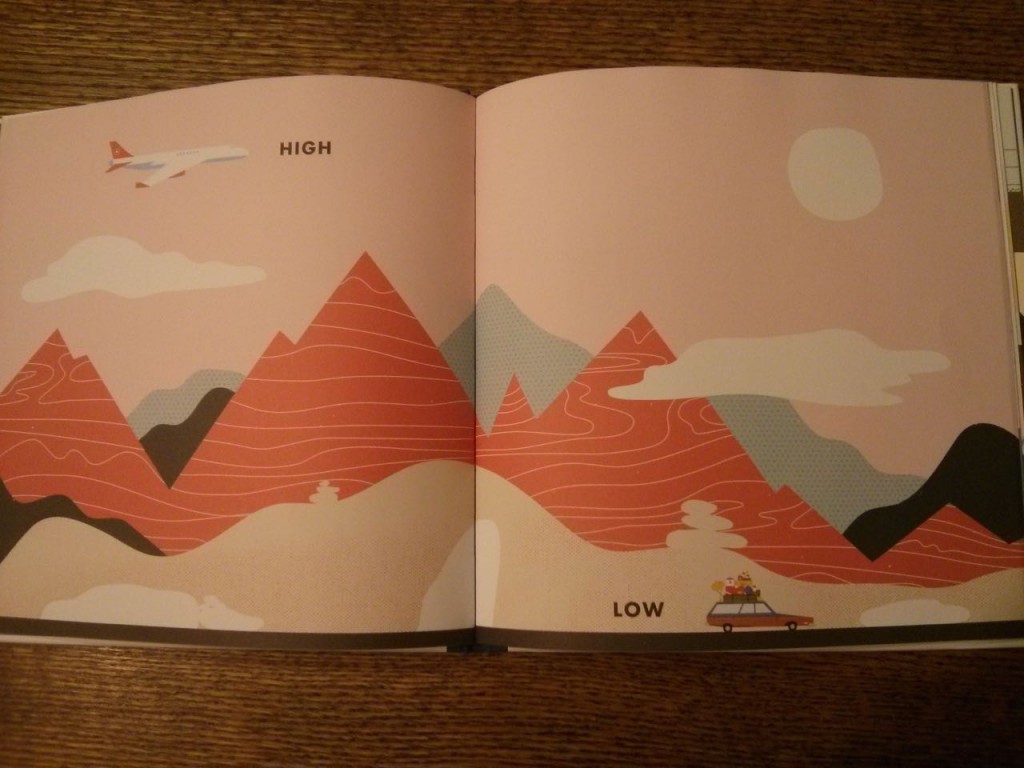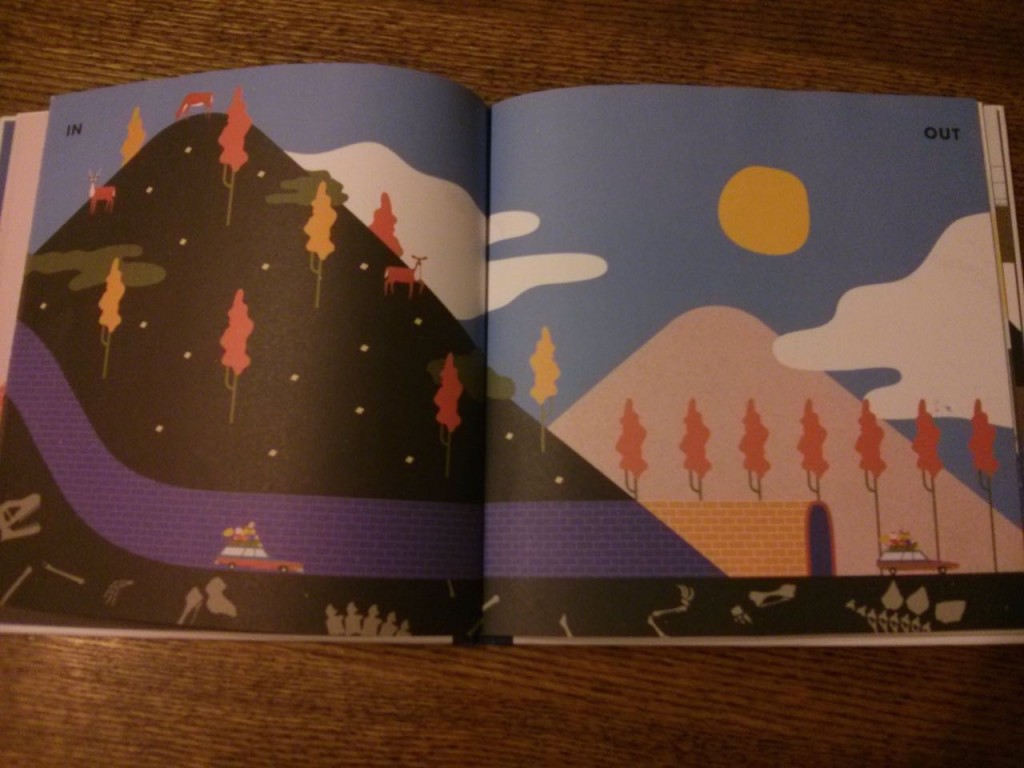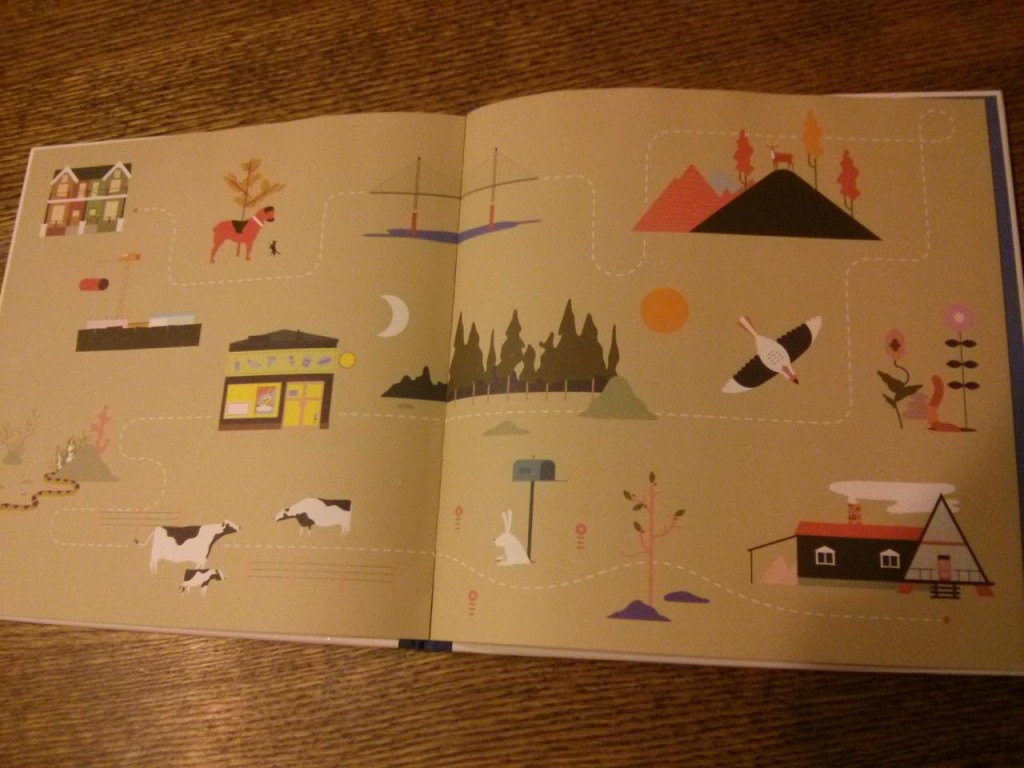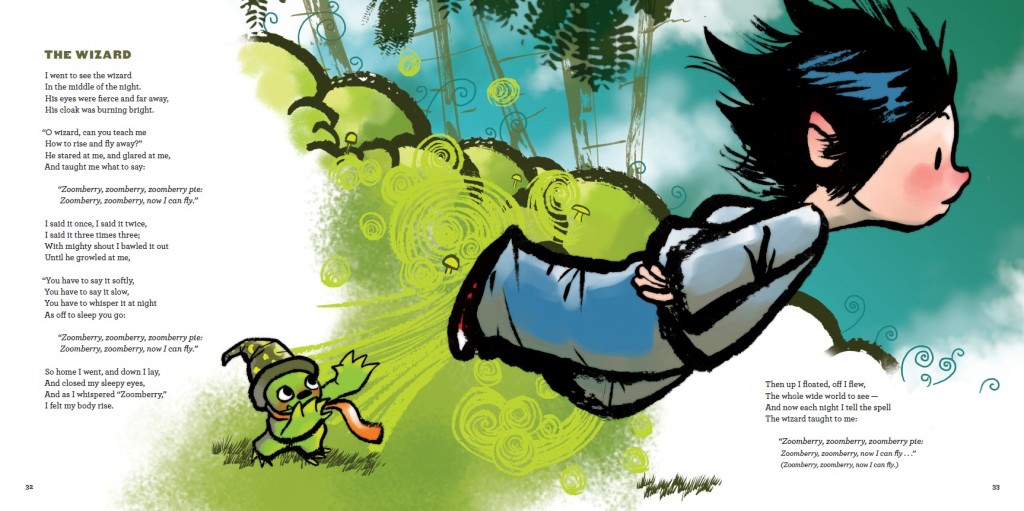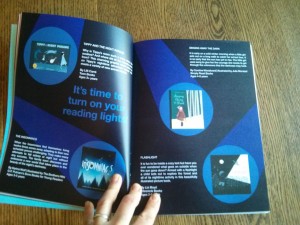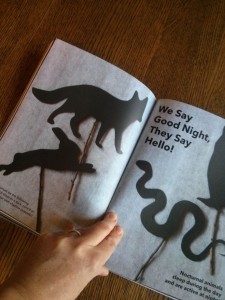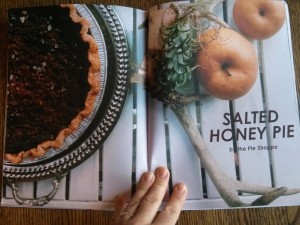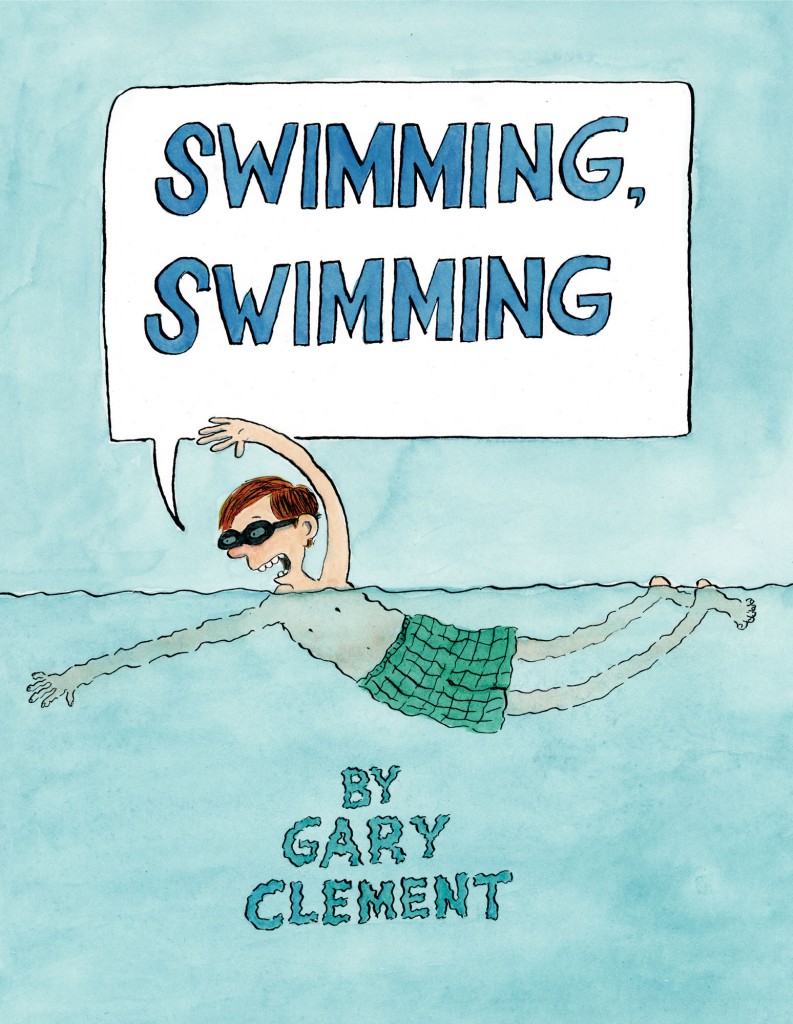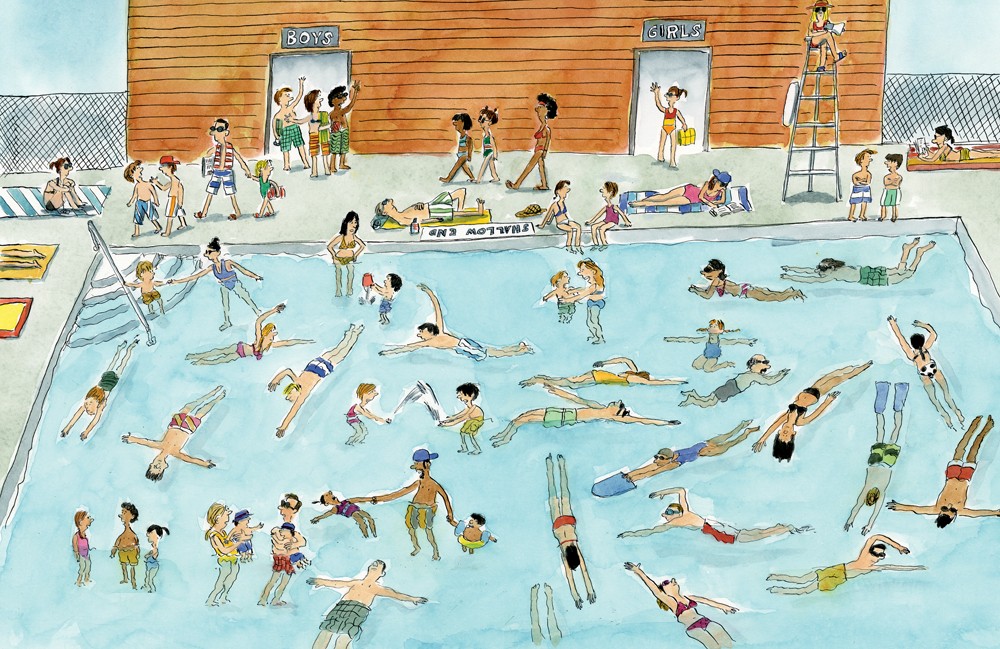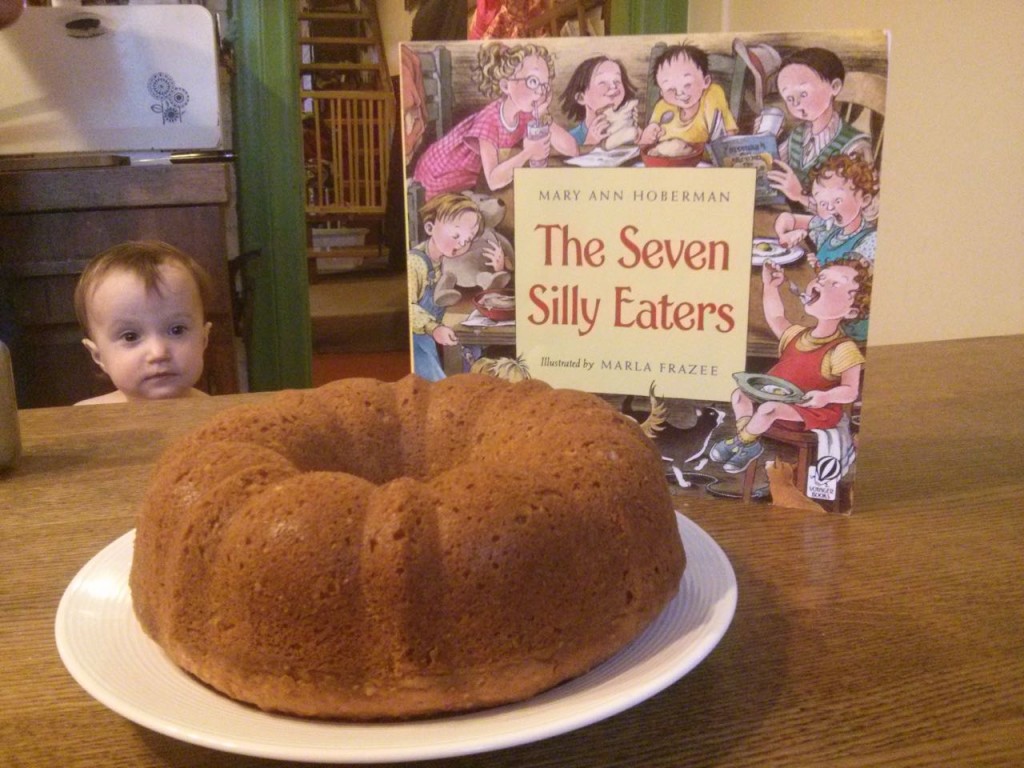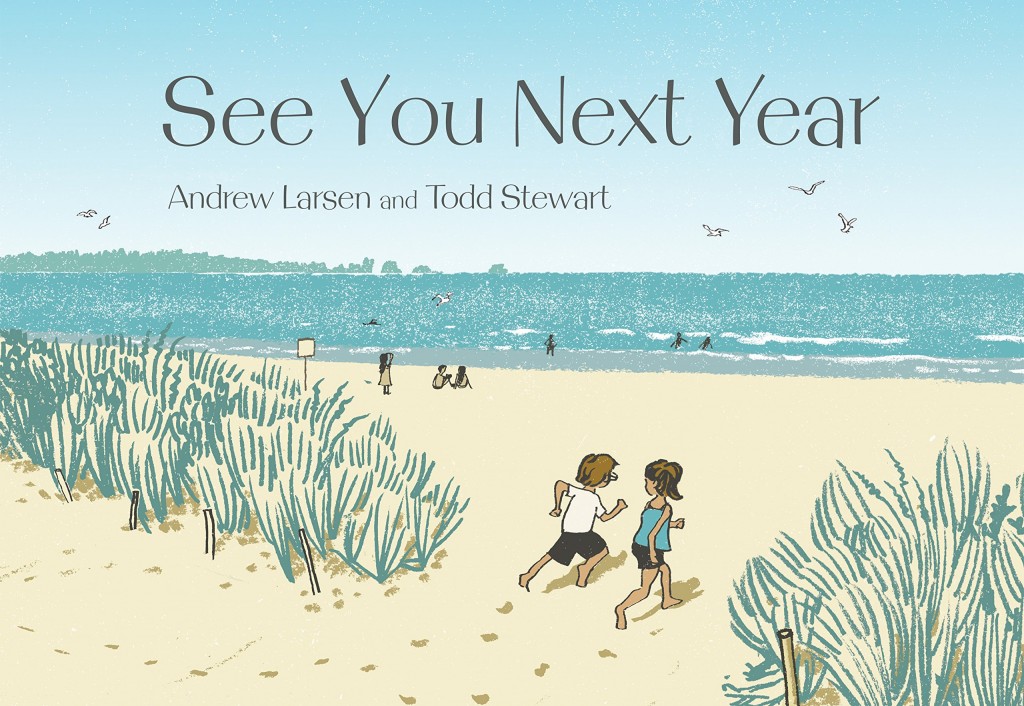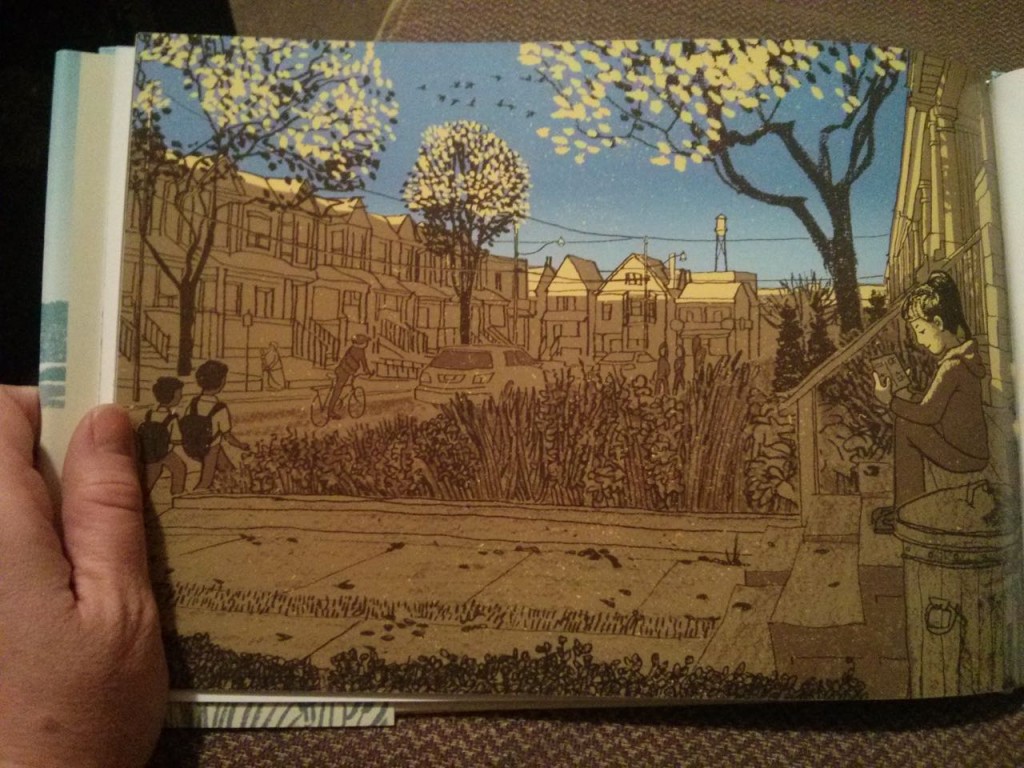May 28, 2015
What’s Inside? by Isabel Minhós Martins and Madalena Matosa
Now that Harriet is older and learning to read on her own, I have a particular appreciation for picture books that are less text-oriented—their game and puzzle nature reminds us that reading is meant to be fun, they’re fun for us to engage with together, and Harriet is content to explore the pages on her own time. But wordlessness makes the stakes are a bit higher—a book like this has to be really good, excellent in both its art and its premise. And What’s Inside? by Isabel Minhós Martins and Madalena Matosa satisfies certainly on both counts.
Published in English by Tate Publishing, the publisher of visual art books associated with London’s Tate Gallery, What’s Inside? was created by the Portuguese duo behind several popular books including When I Was Born. On one hand, What’s Inside? is a kind of inverted Kim’s Game in which readers are delivered a pictorial inventory of interesting vessels and spaces—the hall table drawer, Mum’s handbag, the kitchen counter, my bedroom wall—and then asked to answer questions and find specific details about the objects at hand. Many of these questions are answered on subsequent pages, or lost objects found, separated pairs matched, and broken bits pieced back together.
The questions are great, open-ended, and allow for flights of the imagination (as well as real satisfaction for those who finally locate, for example, just where is Mum’s missing earring after all). What’s really wonderful about the book, however, is how a narrative emerges from all this stuff—we get a sense of who these people are, what are their preoccupations, their quirks and oddities. (Why indeed is there an Ace of Spades in the refrigerator?) Some of the deeper mysteries are never really answered, or at least I have not found the answer to yet, for example to why exactly a wooly hat was brought to the beach—though we have speculated that perhaps the grandmother was knitting it? She had a ball of yarn in her beach bag after all. Perhaps the hat was her finished product? Which is the best thing—how the stories in this story lead us to tell stories of our own.
Readers will delight in the familiarity of household objects, puzzle at the stranger ones, and perhaps begin to think more deeply about what their own stuff says about them. And for those who manage to eventually make their way to the book’s last page, it isn’t finished yet. “Open Your Eyes and Discover More,” the authors implore us, with a list of questions that urge us to go even deeper.
May 21, 2015
This is Sadie by Sara O’Leary and Julie Morstad
I have a special affinity for This is Sadie, the gorgeous new collaboration by Sara O’Leary and Julie Morstad (whose When You Were Small and other books in the Henry series I have loved since before I had my own small people to love them with). I like to imagine it was written just for me. 
It’s got bunting, and swimming, and tea parties, and paper dolls, and even squids, and a spirited girl who gets lost in a whole wide world of books.
It’s got everything that made Morstad’s award-winning How To so wonderful—the mermaid girl, a pair of legs revealing someone hiding in a tree. Plus, O’Leary provides the mischief of Judith Viorst’s and Hilary Knight’s Sunday Morning, the bookish inspiration of Charlie Cook’s Favourite Book by Julia Donaldson, and allusions to Alice in Wonderland, The Jungle Book, Little Red Riding Hood, and Rapunzel. It’s a book about passing time. reading books, and how Sadie likes to make “boats of boxes/ and castles out of cushions./ But more than anything she likes stories,/ because you can make them from nothing at all.” We see Sadie in bed reading a book called The Story of a Snail, then by the next page, her boat box has been transformed into a snail shell.
Morstad’s illustrations are full of jokes and details, things to discover—an apple with a bite out of it, Sadie’s abandoned shoes, a toadstool bedside lamp, a mysterious family of tiny foxes. The book reminds me of Carson Ellis’s Home in how things from around Sadie’s room and in her books recur as images in her imaginings—just as Ellis’s own artist uses the things around her as inspiration for the illustrations in her book. Both This is Sadie and Home make connections between the world around us and where we go in our dreams.
And what anyone needs for dreaming is room to explore. “In This is Sadie, it is pretty easy to draw a direct line between boredom and creativity,” writes O’Leary on her blog, underlining the importance of giving kids the opportunity to make their own play, to dream their way into all kinds of stories—the mermaid, the boy raised by wolves, and “the hero in the world of fairy tales.”
“The days are never long enough for Sadie. So many things to make and do and be.”
May 14, 2015
Drive by Kellen Hatanaka
Mad Men ends on Sunday, after years and years, and in tribute to my favourite show, I’ve picked a picture book this week with a similar aesthetic. I think Betty Draper even owned that station wagon exactly. Drive: A Look at Roadside Opposites is the second book by Kellen Hatanaka, whose Work: An Occupational ABC was on my Hipster Picture Book list last year. While this new book is similarly focussed on design, it’s got more of a narrative, and I like it even better than the first one.
Drive is the story of a journey toward a summer holiday, from the city to the country, and therefore a natural setting for I-spying opposites. The car is packed with summer things—a barbecue and beach balls—and we can only imagine the Are We There Yets? before they finally arrive.
But in the meantime, there is looking out the window. Big, small. Above, below. Winding roads and straight ones.
With all of these Don Draper is actually DB Cooper rumours, this page seems particular eerie.
The illustrations are fantastic, full of funny and interesting details. We particularly like the dinosaurs bones under the mountain in the image below. As with his previous book, Hatanaka plays up the unexpected—I love the “Worm’s Eye View” that opens up into a four page spread of “Bird’s Eye View”, the world spread out below, patchwork fields and the winding road, the car viewed straight down on the roof-rack.
At the end, there is a map, a dotted line tracing the journey from place to place and suddenly the whole thing all comes together—the same story from another perspective.
Drive would be an excellent book to take on the road (perhaps along with See You Next Year?), giving a young reader lots to look at when there’s nothing to see out the window, and perhaps inspiring her to look again and closer at the weird and wonderful world whizzing by outside.
- For more on Mad Men and children’s books, see my post, “What Sally Draper Must Have Been Reading“
May 7, 2015
Melvis and Elvis by Dennis Lee and Jeremy Tankard
 It’s been over forty years since Dennis Lee invented Canadian children’s literature with the publication of Alligator Pie, following it up with Garbage Delight, The Ice Cream Store, and Jelly Belly, books that have moved seamlessly from my childhood to my children’s, so that we all know Suzy Grew a Moustache, In Kamloops, and Hugh Hugh at the age of two, who built his house in a big brown shoe. Combining the rhythms and touchstones of Mother Goose rhymes with contemporary references (and ones more charmingly dated—I’m thinking the rhyme that mentions Eatons, Simpsons and Honest Ed’s) and unabashed Canadiana and Toronto-Centrism, Dennis Lee has provided most Canadians with their poetic foundations.
It’s been over forty years since Dennis Lee invented Canadian children’s literature with the publication of Alligator Pie, following it up with Garbage Delight, The Ice Cream Store, and Jelly Belly, books that have moved seamlessly from my childhood to my children’s, so that we all know Suzy Grew a Moustache, In Kamloops, and Hugh Hugh at the age of two, who built his house in a big brown shoe. Combining the rhythms and touchstones of Mother Goose rhymes with contemporary references (and ones more charmingly dated—I’m thinking the rhyme that mentions Eatons, Simpsons and Honest Ed’s) and unabashed Canadiana and Toronto-Centrism, Dennis Lee has provided most Canadians with their poetic foundations.
And here it is: his latest collection, Melvis and Elvis, is just as good as all the rest.
How does he do it? How has he not yet run out of rhymes? How can something so simple keep seeming so fresh? How can we read a poem that begins, “Mary McGregor/ McGuffin McGee/ Went for a ride/ On the TTC.” and immediately feel as though we’ve always known the poem by heart? How “Is Your Nose Too Small?” (to the tune of “Do Your Ears Hang Low?) so perfectly hilarious? And the collection too with its mix of poems that are tender (“Sleeping With Bears”) and others slightly gross (“In Cabbagetown,” with its exploding bellies) and others naughty (one poem about a stinky friend, and another that ends, “And pounding on your head all night/ Was fun. But very impolite.”). Plus there is a poem about dinosaurs. With a poem about dinosaurs, you can never go wrong.
Dennis Lee is so respectfully and intelligently silly, and so much of the delight of his work comes from words themselves. Because is there anything more fun than rhyming pony with macaroni? Never mind that Yankee Doodle has been doing it for centuries, but in Lee’s “When I Woke Up,” one is reminded of the point of it all. And his rhymes are perfectly complemented by Jeremy Tankard’s illustrations, which seem to combine the otherworldliness (and psychedelic feel) of Frank Newfield’s illustrations for Lee’s first two children’s books, but investing them with far more kid appeal. Returning to the book over and over again, an overarching narrative becomes apparent involving Elvis the Elf and Melvis the Monster of the title, and in the book’s final poem, all the characters from the previous pages assemble to sing a song together, and we delighted in recognition.
May 6, 2015
Small Wonder: A Quarterly Magazine for Kids and Their Grown-Ups
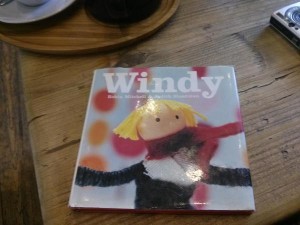 “What a book to discover in a Yorkshire cafe. I want to steal it. No??” I tweeted a couple of weeks ago, delighted to have encountered this wonderful Canadian picture book on a day trip to Ilkley. And I do have a demonstrated history of bibliokleptomania; but no, I determined. The Toast House Cafe in Ilkley was a lovely spot, a worthy home for Windy, I decided. So I left it there for someone else to come across.
“What a book to discover in a Yorkshire cafe. I want to steal it. No??” I tweeted a couple of weeks ago, delighted to have encountered this wonderful Canadian picture book on a day trip to Ilkley. And I do have a demonstrated history of bibliokleptomania; but no, I determined. The Toast House Cafe in Ilkley was a lovely spot, a worthy home for Windy, I decided. So I left it there for someone else to come across.
But then! The cafe itself joined the twitter conversation I’d been having with CanLit enthusiasts back home about the goodness of Windy and other books in the series by Robin Mitchell and Judith Steedman. “glad u didn’t steal it! I put it in our cafe for others to enjoy. I read it 2 my boys yrs ago.” Oh, how embarrassing. To be caught considering becoming red-handed. And so I tried to pass the whole thing off like a lark, oh, I’d never steal a book, which is a total lie, but at least I didn’t steal this one. (And I hope that no one else does, because I’d absolutely be blamed.)
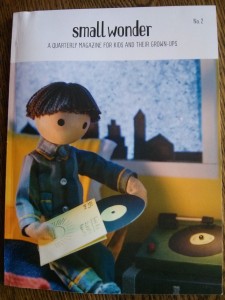 So the creators of Windy got looped into our conversation, and it was here that I discovered that Windy and Friends is now an app. (We downloaded “Sunny’s Dark Night,” and the kids really like it. We will probably get the others.) And from Windy and Friends’ twitter feed, I learned that Sunny is a magazine cover star, and there is such a thing as Small Wonder (subtitled: “A Quarterly Magazine for Kids and Their Grown-Ups”).
So the creators of Windy got looped into our conversation, and it was here that I discovered that Windy and Friends is now an app. (We downloaded “Sunny’s Dark Night,” and the kids really like it. We will probably get the others.) And from Windy and Friends’ twitter feed, I learned that Sunny is a magazine cover star, and there is such a thing as Small Wonder (subtitled: “A Quarterly Magazine for Kids and Their Grown-Ups”).
So naturally I subscribed, which is far more noble than stealing a book, albeit just as impulsive. But I am so glad I did! Our first copy was waiting for us when we got home from vacation, and it’s just as lovely as I was hoping.
The magazine is a beautiful object with lots of thoughtfulness put into its content. It seems born of an ethos that presumes children are deserving of beautiful things, in addition to stories, adventures and wonder. There is lots of opportunities for drawing, creating, reading and dreaming in the magazine, and the issues are substantial enough that you’ll keep them around for awhile. They also recommend Singing Away the Dark by Caroline Woodward and Julie Morstad, so they clearly have impeccable taste. And pie! There is pie. Plus if you look closely, you’ll see that the pie article AND the animal silhouette feature both have Beatles references in their titles, and I don’t know if that was deliberate, but I’d probably give them credit.
Our first issue is themed for darkness, produced a few months ago when winter was drawing in, and now that winter is done, I’m hoping that means we’ll be getting our next issue soon.
April 30, 2015
Swimming Swimming by Gary Clement
I love so many things about Gary Clement’s picture book, Swimming, Swimming, whose text is the lyrics to the traditional song that begins, “Swimming, swimming, in the swimming pool…” First, that it’s a book to be sung to, which is often engaging to readers who might not be engaged by being read to or partial to sitting still. It’s a song that’s fun to sing, even more fun to howl. Second, that it’s a summer-in-the-city book, celebrating the goodness of the public pool, an institution as vital as the library (which is saying something). In our family, we’ve become fond of swimming in the summer at the pool at Christie Pits, which is always crowded and attracts a more diverse crowd than anywhere else we ever go. There’s never any room to actually swim, I’m always irritated by teenage boys plunging in and splashing my children, and probably everyone is peeing, but friction, close quarters and pee are an inevitable part of urban life. There is beauty in the chaos, in the unabashed humanness of it all, and on hot summer days, there is no sweeter relief.
In fun, vintage style cartoon drawings (a style he used to similar effect in the nostalgia-driven Oy, Feh, So?, written by Cary Fagan), Clement depicts a summer day in the life of a swim-obsessed boy—obsession demonstrated by posters on the his walls, a diving trophy on his bureau, the fish in the bowl. And I love too this portrayal of a young person’s singular passion. The boy’s pals come by to pick him up, and together they make their way to the pool, practising their strokes along the sidewalk in a funky choreography.
They get changed, shower, arrive on deck—which is crowded with people of all ages, sizes and colours—and the song begins. It begins with the boy and his friends (the text in voice bubbles), but those around them join in the for the next line. The characters play off each other, acting out their signature strokes (and do like “fancy diving too!” in big rainbow letters, the illustration a vertical spread, as the girl of the group of friends leaps from the diving board in a loop-de-loop). And by the end of the song, everyone in the pool has stopped to face the reader and deliver the song’s final line, a very worthy question: “Oh don’t you wish you never had anything else to do?”
But alas, the pool is closing. (Or has their been a fouling?) Everybody packs up their towels and sunscreen, and makes their way for the locker room, a mirror image of the first half of the book augmented by a quick trip to the nearby ice cream truck (and this is summer-in-the-city indeed). The boy heads home, eats his dinner, feeds the fish, and collapses into bed, the goggles he’s still holding in his hand as he sleeps suggesting that tomorrow might be a day just like today was.
April 1, 2015
Mrs. Peter’s Birthday Cake
I’m about as crazy about literary cakes as I am about books illustrated by Marla Frazee (and written by Mary Ann Hoberman, no less), so I’ve been meaning to write about The Seven Silly Eaters for quite some time. A book that I’m actually ambivalent about, even though it has rhyming couplets. It’s down the other end of the spectrum from Mem Fox’s Harriet, You’ll Drive Me Wild, another book illustrated by Frazee. Harriet is the story of a mom who reaches her breaking point after being sorely tested, and she finally explodes at her extremely irritating (albeit loveable) daughter, and then apologizes and everything is okay. Because mothers are human. Getting angry and upset is what people do, and I think there’s nothing wrong with mothers modelling this. Imagine the child who’s gone through his entire life without learning the fact that people get upset sometimes, that one’s behaviour can have consequences; what a rude awakening the actual world is sure to be.
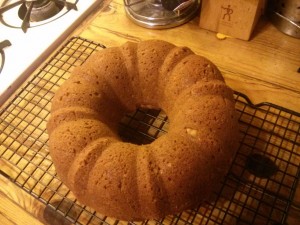 But then there is Mrs. Peters who seems to never have heard of birth control (with seven children in as many years) or setting limits. One by one, each of her children conspires to destroy her person and her cello-playing dreams by making ridiculous culinary demands: her first child refuses his milk unless it’s warmed to a precise temperature; her second will only drink homemade pink lemonade; third would only eat freshly made applesauce; with the fourth it’s oatmeal, unless that oatmeal has the suggestion of a lump and then he dumps it on the cat; the fifth demands homemade bread; and the twins will only eat eggs, poached for one and fried for the other.
But then there is Mrs. Peters who seems to never have heard of birth control (with seven children in as many years) or setting limits. One by one, each of her children conspires to destroy her person and her cello-playing dreams by making ridiculous culinary demands: her first child refuses his milk unless it’s warmed to a precise temperature; her second will only drink homemade pink lemonade; third would only eat freshly made applesauce; with the fourth it’s oatmeal, unless that oatmeal has the suggestion of a lump and then he dumps it on the cat; the fifth demands homemade bread; and the twins will only eat eggs, poached for one and fried for the other.
And while Mrs. Peters is happy in her bubble of domestic chaos—this is certainly the life she chose and she likes the pace—the resentment does eventually seep in. Not overwhelmingly, and she seems to accept it the way she’s accepted everything. “What a foolish group of eaters/ Are my precious little Peters,” she muses as she strains the oatmeal for the 4000th time. She thinks they’ve forgotten her birthday, and then she goes to bed sad—has there ever been anything more pitiful than that?
She should have put a stop to the whole thing years ago. “Make your own fucking applesauce, Little Jack. I’ve got a cello to play.” Mothers are people. It’s a good thing for a child to know.
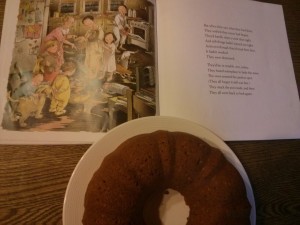 But! Here is the twist. The children have not forgotten their mother’s birthday. Instead, they’ve crept downstairs in the middle of the night to make their mother all their most beloved foods—and do note that they don’t think to make her favourite food. It is quite possible that they’ve never considered that she has one. And because she gave them all a fish instead of teaching them all to fish, proverbially speaking, they have no idea how to cook anything, and so they abandon the project in the middle of it all, their dubious concoctions dumped in a pot and stuffed in the oven.
But! Here is the twist. The children have not forgotten their mother’s birthday. Instead, they’ve crept downstairs in the middle of the night to make their mother all their most beloved foods—and do note that they don’t think to make her favourite food. It is quite possible that they’ve never considered that she has one. And because she gave them all a fish instead of teaching them all to fish, proverbially speaking, they have no idea how to cook anything, and so they abandon the project in the middle of it all, their dubious concoctions dumped in a pot and stuffed in the oven.
Where Mrs. Peters discovers it in the morning: miraculously, a pink and plump and perfect cake!
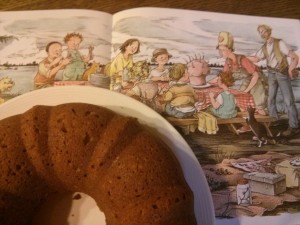 Naturally, we wanted to make it. The Seven Silly Eaters is a book that was born to have a recipe at the end, but there is none. Sadly. And we’re not the only people who thought so (google it: the Internet is rife with parent bloggers making Mrs. Peters’ birthday cake)—due to such a huge demand, Mary Ann Hoberman herself came up with a Mrs. Peters’ birthday cake recipe! So we made it too. Though I thought it was cheating because lemon juice in the milk (to create buttermilk) isn’t really pink lemonade, and she pinks the cake with red food colouring. So I decided to add lemon zest to the cake to make the lemon more authentic, and had the clever idea to make it pink by adding pureed beets to the applesauce (which isn’t in the recipe at all—perhaps Mrs. Peters went on to have a beetroot-loving eighth child?). My clever idea fizzled out, however, because by the time the cake was done, all the pinkness appeared to have been baked out of it. Alas. But the cake was totally delicious. Maybe not delicious enough to make up for more than seven years of domestic tyranny, but I was not asking such things from it.
Naturally, we wanted to make it. The Seven Silly Eaters is a book that was born to have a recipe at the end, but there is none. Sadly. And we’re not the only people who thought so (google it: the Internet is rife with parent bloggers making Mrs. Peters’ birthday cake)—due to such a huge demand, Mary Ann Hoberman herself came up with a Mrs. Peters’ birthday cake recipe! So we made it too. Though I thought it was cheating because lemon juice in the milk (to create buttermilk) isn’t really pink lemonade, and she pinks the cake with red food colouring. So I decided to add lemon zest to the cake to make the lemon more authentic, and had the clever idea to make it pink by adding pureed beets to the applesauce (which isn’t in the recipe at all—perhaps Mrs. Peters went on to have a beetroot-loving eighth child?). My clever idea fizzled out, however, because by the time the cake was done, all the pinkness appeared to have been baked out of it. Alas. But the cake was totally delicious. Maybe not delicious enough to make up for more than seven years of domestic tyranny, but I was not asking such things from it.
 We love this book. I hope I haven’t suggested otherwise. Frazee’s illustrations are so chock full of detail that they can be explored for ages, and there are all kinds of extra-textual stories going on in the background. The family dynamic is fascinating to consider, and perhaps it’s a good discussion point for children—what happens when a family allows its mother to be treated this way? It’s a call for everyone to do her share. It’s a plea for less ridiculousness when it comes to the demands of picky-eaters. But mostly, it’s a cautionary tale for mothers, I like to think. To have limits and live inside them, to not give and give until you have nothing left for yourself. To admit that you too are a person whose needs must be met, and therein lies the negotiation of family life—a useful education for any child.
We love this book. I hope I haven’t suggested otherwise. Frazee’s illustrations are so chock full of detail that they can be explored for ages, and there are all kinds of extra-textual stories going on in the background. The family dynamic is fascinating to consider, and perhaps it’s a good discussion point for children—what happens when a family allows its mother to be treated this way? It’s a call for everyone to do her share. It’s a plea for less ridiculousness when it comes to the demands of picky-eaters. But mostly, it’s a cautionary tale for mothers, I like to think. To have limits and live inside them, to not give and give until you have nothing left for yourself. To admit that you too are a person whose needs must be met, and therein lies the negotiation of family life—a useful education for any child.
March 26, 2015
See You Next Year by Andrew Larsen and Todd Stewart
Our first Andrew Larsen book was The Imaginary Garden, which was a Best Book of the Library Haul almost 4 years ago. Since then I’ve raved about his other books, including In the Tree House and Bye Bye Butterflies, and even more important (though not more important than that he was a finalist for the TD Children’s Literature Award in November), Andrew has become my friend. We met first at the library, obviously, and because we live in the same neighbourhood, we get to walk together to school pick-up when circumstances are fortuitous. I enjoy his company immensely, and have been oh so looking forward to his new book, See You Next Summer, illustrated by Todd Stewart. And happily, it’s everything I was hoping it would be.
It’s a simple story celebrating ordinary wonders, the things we can count on, articulated in the perfect, slight-wistful child’s eye view that Larsen is becoming known for. And it’s a summer book, about a girl whose family returns to the same beachside motel for their vacations every year (“I call it our cottage. But it’s not really a cottage.”—and I appreciate that Larsen’s stories often reflect more modest economic realties, the kind we’re more familiar with in our family). It’s a place where nothing ever changes. On Sunday morning, the girl watches the tractor rake the beach, on Monday nights they go into town to the bandstand where a band plays, and on Tuesday it’s foggy, and so on. Though one thing is different this year—she’s made a new friend. They write postcards together, play in the waves, dig in the sand and roast marshmallows in a bonfire on the beach. And that’s it really. There is a twist at the end that’s really lovely, but it does nothing to counter the constancy of the narrative, to undermine the girl’s faith in sure things. Which I love—this simple celebration of rituals we build our lives around, an articulation of faith a bit less cloying than, say, The Carrot Seed. A affirmation that there are good things in the world, things to count on. Sure, the real world is going to come along and challenge the girl’s faith at some point, because that’s what growing up is, but not everything will get broken. Moreover, in this ever changing world in which we live in (to quote a Beatle), it really is the present moment that matters, and Larsen captures it splendidly—the confidence of the child who knows what she knows, whose confidence of her place in the universe is unquestioned, unshaken. It’s the sort of security that every child deserves to grow up amidst.
Todd Stevens’ illustrations are completely enthralling due his fascinating use of light. See the porch light above (with the red sunset just on the horizon), and the sunrise over the city with half the street still in shade, and elsewhere in the book, the shadow from beach umbrellas, the shadow of evening in later afternoon, how a streetlight shines through fog, the lights of the campfire, from shooting stars, the silhouette of the friend waving against the sun as the girl watches him through the back window of the car as her family begins their journey home. (On the very last page of the book, there is a light switch. I find this most significant, of course). And it occurs to me that his use of light is perfect to show the passage of time during a period in which nothing changes—Virginia Lee Burton pulled off a similar trick with The Little House. Suggesting that things are actually changing all the time, the world around us ever in flux, but that all change is part of a cycle. The images adding an additional layer of depth and poignancy to Larsen’s tale.
March 19, 2015
The Bus Ride by Marianne Dubuc
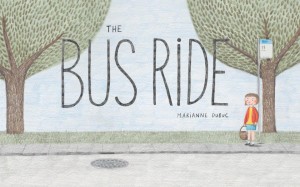 We’re becoming big fans of Marianne Dubuc’s books at our house, having enjoyed In Front of My House and Animal Masquerade. You will recall that picking up the latter title resulted in our entire family eventually assembling on the couch, gathering together captured by the book’s magic, and laughing hysterically at the surprises and absurdity. Dubuc’s latest book, The Bus Ride, similarly engages and surprises, and while it’s is very loosely based on the Little Red Riding Hood narrative, a more fitting descriptive for the story would be “curiouser and curiouser.”
We’re becoming big fans of Marianne Dubuc’s books at our house, having enjoyed In Front of My House and Animal Masquerade. You will recall that picking up the latter title resulted in our entire family eventually assembling on the couch, gathering together captured by the book’s magic, and laughing hysterically at the surprises and absurdity. Dubuc’s latest book, The Bus Ride, similarly engages and surprises, and while it’s is very loosely based on the Little Red Riding Hood narrative, a more fitting descriptive for the story would be “curiouser and curiouser.”
The Bus Ride is the story of a little girl’s first ride along on a city bus to visit her grandmother’s house. Her mother sees her off at the bus stop, ensuring she’s got a snack and a sweater in case she gets cold. And from there the rest of the story is of the bus ride, the bus’s interior each two-page spread. Passengers embark at the front doors and alight through the back. The little girl narrates what she sees in a sentence or two, although the real story is happening in Dubuc’s illustrations. A cat is knitting a scarf that grows ever-longer, a mouse is reading a tiny book, a family of rambunctious moles (I think?) climbs on board and end up swinging from the overhead bars (and one chews on a piece of gum he finds on the floor). A family of wolves boards the bus and the little girl makes friends with the wolf-boy who’s about her age—they share her cookies. A sleepy sloth snoozes the ride away. Someone’s hiding behind a newspaper whose headlines are ever-changing and reference what’s going on the pictures. I admired in the stolid bear in his big blue boats.
 They pass through the forest, through a tunnel. Children run amuck. The fox keeps sleeping. The owl woman in the hat seems quite uncomfortable, and characters keep turning up in different places. The turtle gets nervous and hides in his shell. A wannabe pickpocket—a fox, of course—boards the bus, and and the little girl helps to divert a crime. And what is the beaver carrying inside his really big box?
They pass through the forest, through a tunnel. Children run amuck. The fox keeps sleeping. The owl woman in the hat seems quite uncomfortable, and characters keep turning up in different places. The turtle gets nervous and hides in his shell. A wannabe pickpocket—a fox, of course—boards the bus, and and the little girl helps to divert a crime. And what is the beaver carrying inside his really big box?
While The Bus Ride is first a story of one girl’s first independent journey into the world, it’s fundamentally a story of how interesting the world is and how fascinating it is to be in the midst of it all. At the end of the bus ride, the little girl reflects on all the stories she has to tell her grandmother now. Hers is an apprenticeship in narrative, but it is for the reader as well, who assembles her own story based on the curious scenes depicted in Dubuc’s illustrations, which are detailed and accessible, appealingly rendered in pencil crayon. And like all the very best picture books, it’s completely different with every encounter.
March 16, 2015
Best Book of the Library Haul: March Break Edition
 Our March Break plans are modest ones: museum, art gallery, library, visits with friends in the morning, and then Iris nap times in the afternoons while Harriet watches movies and I work. Unlike the previous years, Stuart doesn’t have the week off too, and I’m less interested in adventuring without him. Though tomorrow I am taking Iris on the streetcar untethered, with only Harriet for support, moral or otherwise, which might be more adventure than I’m bargaining for. Other good things about March Break are that spring temperatures are here and it’s glorious, and also that it’s the first March Break ever during which I’m not awaiting biopsy results—that was always really poor scheduling on my part.
Our March Break plans are modest ones: museum, art gallery, library, visits with friends in the morning, and then Iris nap times in the afternoons while Harriet watches movies and I work. Unlike the previous years, Stuart doesn’t have the week off too, and I’m less interested in adventuring without him. Though tomorrow I am taking Iris on the streetcar untethered, with only Harriet for support, moral or otherwise, which might be more adventure than I’m bargaining for. Other good things about March Break are that spring temperatures are here and it’s glorious, and also that it’s the first March Break ever during which I’m not awaiting biopsy results—that was always really poor scheduling on my part.
 Another good thing is that we got a fantastic library haul last week, which has meant it’s March Break, and the reading is splendid. And the best of the bunch is The Worst Princess by Anna Kemp and Sara Ogilvie. I’ve been championing anti-princess princess books for awhile now, but this one really takes the tiara. It’s in rhyming couplets, first, which is my definition of a picture book to die for. And tea and teacups and teapots recur throughout the narrative, which happens in most of my favourite books, and the children delight in pointing them out.
Another good thing is that we got a fantastic library haul last week, which has meant it’s March Break, and the reading is splendid. And the best of the bunch is The Worst Princess by Anna Kemp and Sara Ogilvie. I’ve been championing anti-princess princess books for awhile now, but this one really takes the tiara. It’s in rhyming couplets, first, which is my definition of a picture book to die for. And tea and teacups and teapots recur throughout the narrative, which happens in most of my favourite books, and the children delight in pointing them out.
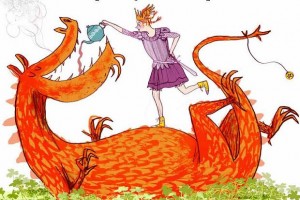 The Worst Princess is Sue, whose been waiting around for her life to begin, reading up on all the stories to find out just how one goes about landing a princess. She’s grown her hair to extraordinary lengths, kissed frogs, slept on peas, all for naught. She is lonely and terrifically bored, and then delighted when her prince finally comes. Except that he’s built her a tower and expects her to stay in it locked away from the world—it seems that the prince has read all the books too. But Princess Sue has no truck with that. When not long after, she spies a dragon in the distance, she flags him and down and makes a deal (over a cup of tea, of course). He blows down her tower, sets the prince’s pants on fire, and then Sue and Dragon take off on a series of adventures, “making mischief left and right/ for royal twits and naughty knights.”
The Worst Princess is Sue, whose been waiting around for her life to begin, reading up on all the stories to find out just how one goes about landing a princess. She’s grown her hair to extraordinary lengths, kissed frogs, slept on peas, all for naught. She is lonely and terrifically bored, and then delighted when her prince finally comes. Except that he’s built her a tower and expects her to stay in it locked away from the world—it seems that the prince has read all the books too. But Princess Sue has no truck with that. When not long after, she spies a dragon in the distance, she flags him and down and makes a deal (over a cup of tea, of course). He blows down her tower, sets the prince’s pants on fire, and then Sue and Dragon take off on a series of adventures, “making mischief left and right/ for royal twits and naughty knights.”








